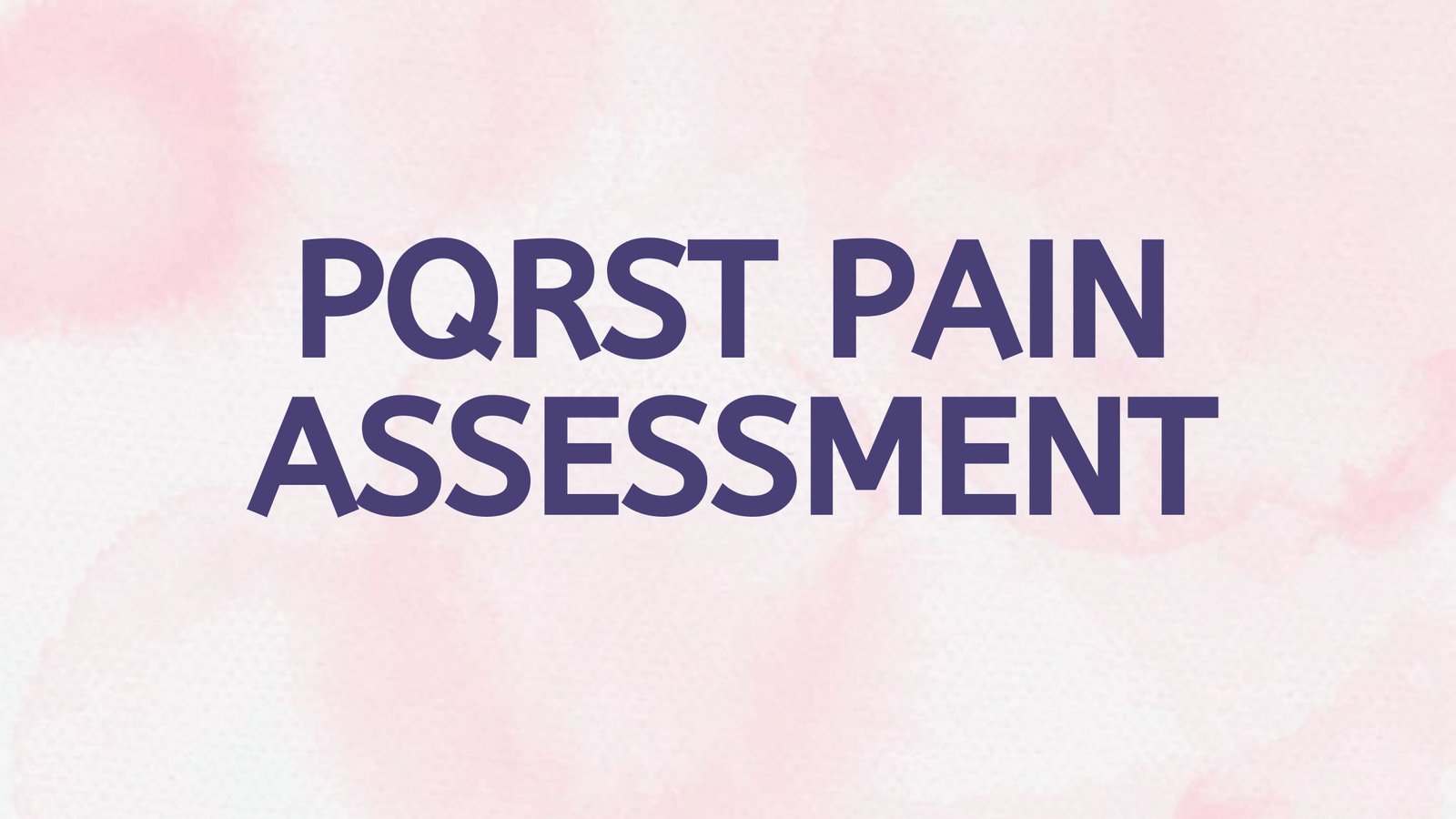PQRST For Pain Assessment – Some Easy Methods Explained!

Pain is an unpleasant sensory and emotional experience that may be due to actual or potential tissue damage. Pain is a very subjective experience. There are no accurate tools for measuring pain. Doctors, nurses, and other medical practitioners use different techniques to understand the level of pain and give the right treatment. There are many pain assessment methods and tools to get a proper picture of the suffering. Self-report from the side of the patients is considered to be the best and most accurate measure of pain.
A pain scale is a tool employed by doctors to assess a person’s pain. A specially designed scale is used to report the pain of the patients with the help of a doctor, parent, or guardian. These kinds of tools are used during admission to a hospital, during a doctor visit, after surgery, or during physical activity. By using this pain scale, doctors get to understand certain aspects of a person’s pain. Some of the aspects that are understood are pain duration, severity, and type.
Pain scales are helpful for medical practitioners to make a proper diagnosis, create a treatment plan, and measure the effectiveness of treatment. There are different pain scales and pain assessment methods for people of all ages, from newborns to seniors. It is also available for people with impaired communication skills.
Pain Assessment Tools
There are two categories of pain scales. They are unidimensional and multidimensional pain scales. Unidimensional pain scales are a simple way for patients to rate the intensity of pain. They mainly use numbers, words, images, or descriptors to measure the intensity of pain or pain relief. Numeric rating scales are the most commonly used pain scale. In this scale, the patient rates his/her pain on a scale from 0 to 10 or 0 to 5. Zero indicates no pain and values 5 or ten mean the most extreme pain.
The visual analog scale is a similar pain scale. In this scale, the patient marks a point on a 10-centimeter line printed on a piece of paper according to the pain he/she feels. The starting point means no pain and the ending point means the worst pain. The doctor measures the distance to the point market by the patient and comes up with a pain score.

The categorical pain scale is another unidimensional pain scale in which the intensity of pain is described using words like mild, discomforting, distressing, horrible, and excruciating. Pain scales for children use images of faces with various expressions of pain. The child will select the face that they connect with the most in their pain experience.
Multidimensional tools are the second category of pain assessment. They are not as widely used as unidimensional pain assessment methods. They are not as simple and direct as the other methods explained before. They provide a more detailed picture of the pain. The initial pain assessment tool is one among them. This pain assessment tool provides the doctor with information about the characteristics of pain. This pain scale has a diagram of the body in which the patient can mark the area of pain. It also contains a scale to rate pain and a space to give more comments.
The brief pain inventory is another multidimensional pain assessment tool. It includes a series of questions about the pain felt over the last 24 hours. McGill pain questionnaire is a similar pain assessment tool. It asks several questions and assesses a patient’s pain based on the words described to describe the pain.
PQRST – What Does It Stands For?
The PQRST method is an important method of assessing pain in patients. It helps to accurately describe, assess and document the pain of a patient. This method helps to choose the appropriate pain medication and evaluate the response to the treatment. The patients are asked a specific set of assessment questions by nurses or other medical professionals to report their pain. It is through the responses of the patients that the physician gets a clear understanding of the condition of the patient. By this method, proper diagnosis and treatment are achieved.

The word PQRST is a mnemonic in which the letter P stands for Provocation and palliation of symptoms, the letter Q stands for quality, the letter R stands for region and radiation, the letter S stands for severity, and the letter T stands for timing.
The initial set of questions is about the onset of the event. The patient is asked what he/she was doing when the pain started. They are asked whether they were active, inactive, and or stressed. Did the specific activity they were doing prompt or start the onset of pain? They are asked if the onset of pain was sudden, gradual, or part of an ongoing chronic problem. The letter P stands for provocation and palliation of symptoms. In this part, the questions are asked about activity, position, and adjuvant.
Patients are asked if walking, standing, lifting, twisting, reading, etc have any effect on pain. They are asked about the positions that cause or relieve pain. Provide examples of position to the patient like sitting, standing, supine, lateral, etc. Next, ask questions about the type of medication that relieves the pain. Ask if the use of heat or ice packs alleviates pain. Enquire if the patient has used alternative therapy like massage or acupuncture before. Also ask if any movement, pressure (such as palpation), or other external factor makes the problem better or worse. Also, ask whether the symptoms relieve with rest.
The next set of questions is about the quality of pain. The patient is made to describe the quality of the pain, like whether is it throbbing, dull, aching, burning, sharp, crushing, shooting, etc. Patients are asked questions that can be open-ended. Questions like “Can you describe it for me?” can be asked. This will elicit proper responses from the patient whether the pain is sharp, dull, crushing, burning, tearing, or some other feeling of pain, along with the pattern, such as intermittent, constant, or throbbing.
The next set of questions is about the region and radiation of the pain. Getting the proper information about the region of pain and whether it radiates can provide clues to the underlying medical causes. Some pain radiates, that is, it moves from one point to other. For example pain in the shoulders sometimes radiates or travels through the arms and fingers. It is good to specify if the pain started in one place and then over time began to move to other parts of the body. Referred pain is feeling pain in a location other than the original site of the painful stimulus. Localized pain is when pain stays in one location and does not spread.
The next part of the pain assessment is a pain scale. The physician as the patient to rate their pain on a scale of 0 to 10. Zero means virtually no pain and 10 means the worst possible pain. Although the pain is subjective, this rating can still be useful in providing some insight. The next set of questions is about the timing of pain. Questions are asked to identify when the pain started, under what circumstances, duration, onset (whether it is gradual or happened all of a sudden), frequency, and whether it is acute or chronic. The patient is asked how long the condition has been going on and how it has changed since the onset, that is, whether it became better or worse. Also, ask if it has happened before and how it has changed since the onset.
Conclusion
PQRST method of pain assessment is an efficient tool in the medical field to get a proper idea about the pain experienced by the patient. The result of this assessment is beneficial in making a proper diagnosis of pain and thus correct treatment can be delivered to the patient. A properly set questionnaire is important in understanding the current situation of the patient. The PQRST method is useful in this regard.
Dr. Edward Zelman
Dr. Edward Zelman is a distinguished and highly respected medical professional who has dedicated his career to the field of general medicine. With a profound commitment to patient care and a wealth of knowledge acquired over decades of practice, Dr. Zelman has earned a reputation as a trusted healthcare provider in his community. With a career defined by excellence and an unwavering commitment to the betterment of his patients and the broader community, Dr. Edward Zelman stands as a pillar of the medical field, dedicated to the principles of healing and compassionate care. At present, Dr. Edward Zelman is researching safe and effective natural remedies that can restore as well as maintain the youthful functioning of the body.
View All By Dr. Edward






